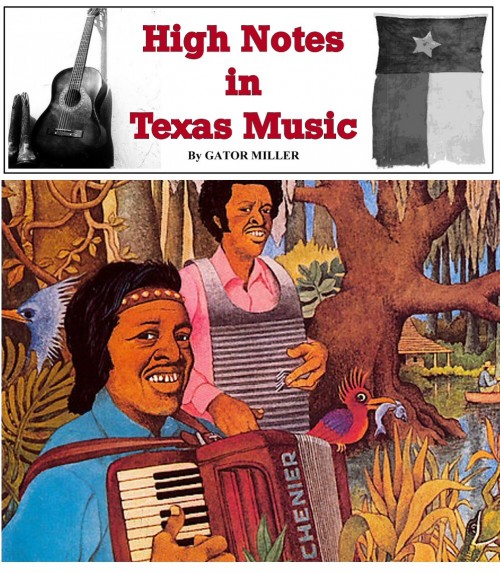GREAT MOMENTS IN TEXAS MUSIC: Clifton Chenier Invents Zydeco
“Louisiana ‘Bayou Land’ has produced some of the greatest talents…..Fats Domino, Pete Fountain, Louis Armstrong to name but a few. But out of this comes a man and his accordion. The blues, the lonely boy, Clifton Chenier. The only black man that can play a lily-white dance on Wednesday and a solid black dance on Thursday and pack them in each night.
Then from Frisco Bay to the European Folk Festival…. satisfying the young and rearranging memories for the old. Clifton is his own. When you hear his records anywhere you know it’s him….people don’t have to tell you. A very gifted man!”
So read the liner notes to Clifton Chenier’s ‘Bayou Soul’ LP, originally released on Crazy Cajun Records. It is a typical piece of folksy whimsy by label owner Huey P. Meaux – the “Crazy Cajun”. Notice there is no mention of zydeco music, but there is reference to Clifton’s multi-racial appeal, the blues influence, the dance aspect, and most precious of all, his very identifiable sound.
When most people think of Zydeco, they assume it is a kind of music which was created in Louisiana. With all due respect to our gumbo and crawfish eating neighbors, the fact is that Zydeco was invented in Texas, although the group of musicians who made it become popular were almost exclusively Cajuns, “Coonasses” and Creoles from “across the river“. Among these, the King of Zydeco, Mr. Clifton Chenier, is preeminent. Chenier was from Louisiana, but Zydeco was invented and popularized in hundreds of honky-tonk bars between Houston and Lake Charles in lower east Texas during the 1960s & 70s.
When Clifton Chenier and his band played at Johnny Land’s Club in Port Arthur in the 1950s, little old ladies and young girls would get up and dance ecstatically. Toes would be tapping at every table. Zydeco music was invented by accordion player Clifton Chenier after he first came to Texas just looking for a job to support his family.
In those days, when Creoles and Cajuns migrated from Southwest Louisiana they tended to go where the work was – and that wasn’t New Orleans. They went west to places in Texas like Port Arthur, Beaumont, Galveston, and Houston. In those days, the paying jobs were found in the refineries, and that’s where they landed. A few got lucky and found work around Lake Charles, but most of the jobs were in Texas. That’s why you don’t see very many Zydeco bands working in New Orleans – in fact, they’re only found in the tourist traps there. Zydeco music, with all of its’ Cajun roots, is primarily a southeast Texas phenomenon.
Born in Opelousas in 1925, Clifton was the son of a sharecropper and amateur accordion player, Joe Chenier, and the nephew of a guitarist, fiddler and dance club owner, Maurice “Big” Chenier. He literally learned to play the accordion on his father’s knee.
Young Clifton found his earliest influences in the blues of Muddy Waters, Peetie Wheatstraw and Lightnin’ Hopkins, the New Orleans R&B of Fats Domino and Professor Longhair, the 1920s and ’30s recordings by accordionist Amede Ardoin, and the playing of his own childhood friends, Claude Faulk and Jesse and Zozo Reynolds.
Acquiring his first accordion from a neighbor, “Easy” Blasa in 1937, Chenier was taught the basics of the instrument by his father.
By 1944, Chenier was performing in the dance halls of New Ibreia, while picking sugar cane by day to feed his family.
In 1946, he followed his brother Cleveland to Lake Charles. He absorbed a wealth of tunes from musicians such as Zozo Reynolds, Izeb Laza, and Sidney Babineaux, who, despite their talents, were never recorded.
The following year, Chenier traveled to Port Arthur with his wife Margaret, where he worked for the Gulf and Texaco refineries until 1954. Still playing music on weekends,
Chenier was “discovered” there by radio disc jockey J.R. Fulbright, who recorded him at radio station KAOK in Lake Charles, and issued a few records of those live sessions.
Chenier’s first national attention came from the first KAOK single, “Ay Tete Fille (Hey, Little Girl)”, a cover of a Professor Longhair tune, released in May of 1955.
The song was one of 12 that he recorded during two sessions produced by Bumps Blackwell, best known for his work with Little Richard.
By 1956, Chenier had quit his day job to devote full-time to music, touring with his band, the Zydeco Ramblers, which included blues guitarist Philip Walker. The following year, Chenier signed with the Chess label in Chicago.
In 1958, Chenier moved to Houston, and from here played packed shows all over the south. Although he toured with Etta James throughout the United States, Chenier’s career suffered when the popularity of ethnic and regional music styles began to decline.
He recorded thirteen songs between 1958 and 1960, but none of them charted.
During the 60s, Chenier played a major concert in San Francisco and recorded for a number of notable labels, including Argo and Arhoolie Records, in a bid to reach a wider audience. “Squeeze Box Boogie” became a hit in Jamaica in the 50s, but generally his style of music was not widely heard before the 60s.
The turning point in Chenier’s career came when Lightnin’ Hopkins’ wife, who was a cousin, introduced Chris Strachwitz, owner of the roots-music label Arhoolie, to his early recordings. Strachwitz quickly signed Chenier to Arhoolie, producing his first hit single in four years, “Ay Yi Yi”/”Why Did You Go Last Night”.
In 1976, Chenier recorded one of his best albums, Bogalusa Boogie, and formed the Red Hot Louisiana Band, featuring tenor saxophonist “Blind” John Hart and guitarist Paul Senegal.
Chenier reached the peak of his popularity in the 1980s. In 1983, he received a Grammy for his album “I’m Here!” recorded in eight hours in Bogalusa, Louisiana.
The following year, he performed for President Reagan at the White House.
Chenier crafted the definitive zydeco sound that still sets the standard. He did so by creating an artful blending of Creole folk with rhythm & blues.
Chenier adapted this material to the accordion and sang the lyrics in Creole French.
Beyond these innovations, Chenier’s skill as an accordionist has yet to be surpassed.
In later life, in addition to suffering from diabetes, he had part of his right foot removed due to a kidney infection in 1979. Although this prevented him from touring as frequently, Chenier continued to perform until one week before his death on December 12, 1987. Following his death, his son, C.J. Chenier, took over leadership of the Red Hot Louisiana Band.
Three generations of Chenier musicians have now made their mark in Texas. (GATOR)



